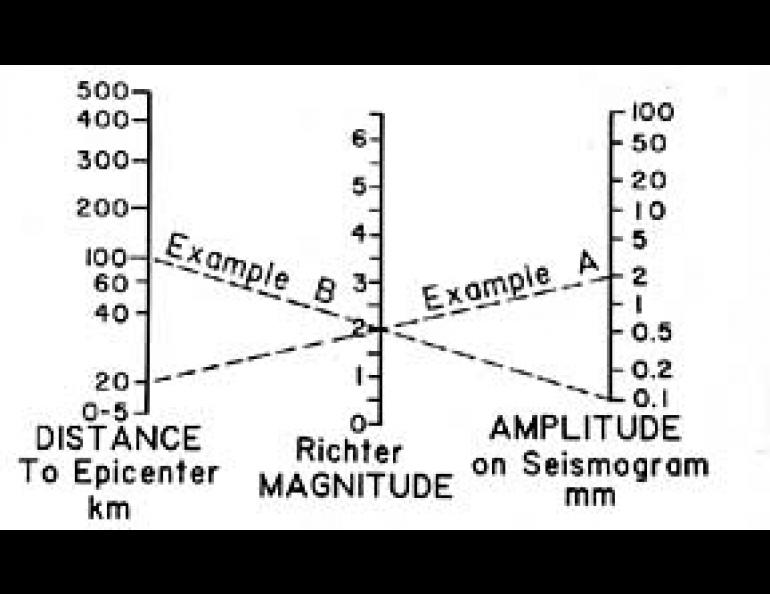
The Richter Magnitude Scale
Magnitude scales in general often seem to be devised with a devilish intent to mislead. Sometimes they don't even point in the same direction. The magnitude of a disaster, for instance, goes up as the disaster becomes worse, but the magnitude of a star goes down as the intrinsic brightness becomes greater. If someone mentions to a scientist that a quantity increases by an order of magnitude, he usually understands it to mean that it is multiplied by a factor of 10. But to some people it means that the quantity doubles, which (to further muddy the waters) is the same as saying that it increases 100 percent.
To most Alaskans, the first thing that comes to mind when the word "magnitude" is mentioned is the Richter earthquake magnitude scale, because earthquakes here are a part of everyday life. But regardless of how many times the term is used, there is almost always considerable confusion as to exactly what it represents.
Before explaining what the Richter magnitude scale is, let's examine a few things that it is not.
It is NOT an instrument. It's a fairly common occurrence for visitors at the Geophysical Institute's seismology laboratory to ask if they can see the Richter scale as if it were a piece of equipment, but on that request we have to disappoint them.
The Richter scale does NOT go from 1 to 10, or between any limits at all. Magnitude 0 and smaller earthquakes happen all the time. As a matter of fact, the smaller they are, the more frequently they occur, but the instrumental detection limit extends only to around magnitude -3. This represents about the energy equivalent of the explosion from a small firecracker at a depth of five miles. At the other end of the scale, a Richter magnitude could be assigned to an earthquake of any size, no matter how great, but the largest earthquakes ever recorded have not exceeded about magnitude 9. It is likely that this nearly represents the upper limit of stress that the earth's crust can withstand before rupturing and releasing the accumulated strain.
An earthquake's Richter magnitude does NOT change with distance from its source. A common inquiry made by a call to the seismology lab might go something like this: "I heard on the news that there was a magnitude 7 earthquake in the Aleutians. What magnitude was it in Anchorage?" This is equivalent to saying "I heard that there was a 50-kiloton nuclear test in Nevada. How many kilotons was it here?" The magnitude of an earthquake is a function of the energy released at its source. The ground effects, known as earthquake "intensity," die away with distance, but an earthquake of, say magnitude 5 is a magnitude 5 earthquake no matter where on the globe it occurs.
If these are some of the things the Richter scale is not, then what exactly is it?
Charles F. Richter devised his magnitude scale in the mid-1930s while investigating earthquakes in California. He used seismographs which magnified ground motion 2800 times, and as a baseline, he defined a magnitude 0 earthquake as being one that would produce a record with an amplitude of one-thousandth of a millimeter at a distance of 100 kilometers from the epicenter (such small deflections are so difficult to see that much stronger magnification is used in modern seismographs and an appropriate scaling factor applied). From that baseline, magnitudes can go either up or down with multiples of ten in ground motion (and deflection on the record) representing individual steps in the Richter scale. For instance, if a deflection of one-thousandth of a millimeter at a distance of 100 kilometers indicates a magnitude 0 earthquake, then motion of 1 millimeter (three orders of magnitude or 1000 times the motion of the magnitude 0 earthquake) at the same distance would represent a magnitude 3 earthquake. A magnitude 8 earthquake at 100 kilometers would then result in a deflection on the record (in millimeters) increased five more times by a factor of 10, or 100,000 millimeters in all -- greater than the length of a football field. Of course, such large deflections are impossible to measure, so observations from very distant recording sites must be used.
Although few people are likely to believe it, our hypothetical magnitude 8 earthquakes thus translates into 1/2800th of 100,000 millimeters, or only about an inch and a half of actual back-and-forth vibration at 100 kilometers (about 60 miles). The huge displacements that shatter roads and topple buildings, such as in the magnitude 8.4 Good Friday Alaska earthquake resulted from the cumulative effects of sustained shaking and from ground failure.
Image caption cont: In the examples shown, a magnitude 2 earthquake would produce a deflection of 0.1 millimeter from an earthquake 100 kilometers away, or a deflection of 2 millimeters if it were only 20 kilometers distant.





